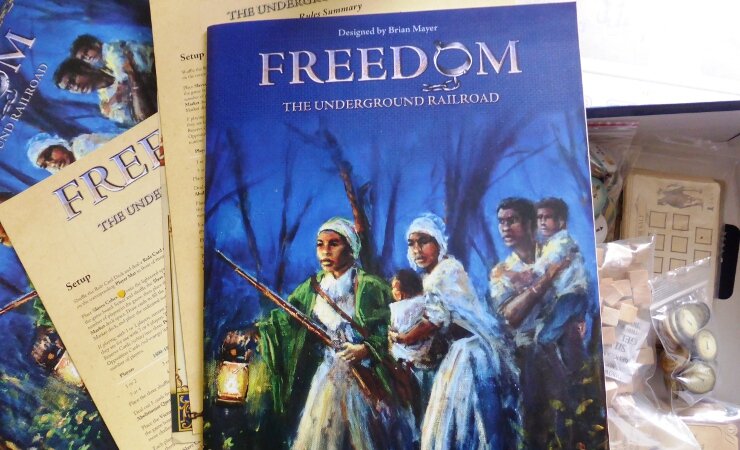
Previously, I looked at the box contents for Freedom: The Underground Railway. This article gives a brief overview of the main game mechanics. Obviously, it cannot give a full account of how everything works, as it is a fairly complex game.
Freedom – The Underground Railroad is an engaging cooperative game about a pivotal time in American history. Players assume the roles of important historical Abolitionist characters pitted against the slave economy from the early 1800’s thru the Civil War.
Players succeed together by balancing their actions between raising funds for the Abolitionist cause and helping slaves as they move from the Southern States to freedom in Canada. But every move risks alerting the slave catchers, who roam the board trying to return the runaway slaves back to the plantations.
As the description notes, the game is about (a) freeing slaves and (b) raising funds for the Abolitionist cause. These two parts make also make the victory conditions for the game.
#1 – First Goal of the Game: Fund the Abolitionist Cause

On the left-hand third of the board, the “newspaper-style”-section presents the tokens and cards. There are three types of tokens, from top to bottom, (1) Support tokens, (2) Conductor tokens, and (3) Fundraising tokens.
Purchasing the first kind, Support tokens, represents funding the Abolitionist cause. The game can only be won if all these tokens have been bought. In essence, they are a money-drain to the players. The more players, the more Support tokens are in the game.
However, buying the Support tokens also unlocks the later time-periods (from left to right), which unlocks better variants of the other types of tokens and better cards.
It’s a fairly abstract mechanic, but it works well enough to balance the game for different player numbers and to manage the time-periods.
#2 – Moving Slaves to Canada

The central aspect of the game revolves around moving the slaves – the wooden cubes – from plantations in the South of the US through the North and into Canada.
The standard method to move slaves are the second kind of tokens, Conductor-tokens, seen above. In the first time-period (1800-1839), the basic Conductor-token allows player to move 3 slaves (or cubes) 1 distance each. Later time-periods offer more effective Conductor-tokens. The number of tokens in the game is limited.
Event cards or special abilities by some of the player roles can also be used to move slaves. Slaves arriving in Canada are considered “freed” and count towards winning the game.

Again, victory conditions differ depending on the number of players. A 2-player game needs to free a total of 13 slaves. A 4 player game needs to free 27 slaves.
If players purchase all Fundraising-tokens and move enough slaves to Canada before the game ends (8 rounds), they win.
#3 – First Complication – Slave Catchers

Of course, just moving slaves/cubes up north isn’t easy. Aside from the logistics of limited resources, there are slave catchers on the prowl.
Freedom is a cooperative game. The slave catchers move entirely by game mechanics alone, first by a role of two special dice (above) that tell you which slave catcher will move and in which direction (black arrows for east, white arrows for west) and how many fields.
In the example above, the blue slave catcher would move 1 field to the east along his blue dotted line, catching the slave in Cleveland.
Slave catchers are also triggered by slaves moving on to their “lines”. This, more than the dice, adds the strategic component to moving the slaves/cubes. The sequence in which you move them – drawing one or two slave catcher to the west to open passages in the east, etc.. – can make or break the game.
I found this works better in small games with fewer players. With more players, and more slaves/cubes on the board, the space for strategic movement is often lost.
#4 – Second Complication – Slave Market

The second complication is a steady stream of new slaves arriving from a deck of cards named “Slave Market” into the plantations.
Space in the plantations themselves is limited, and new slaves that cannot be placed count go directly to the “slaves lost” box (see above). Once that box is full, players lose the game. The numbers again depend on the number of players. A 1 or 2-player game could see the 5-new-slaves card to the left above. A 4-player game will often see the 9-new-slaves card.
In a nutshell, it adds more pressure to move slaves/cubes up north at a constant rate.
#5 – Mixing It Up – The Cards

Last but not least, there are the cards. At any given time, there are (up to) 5 cards available for purchase for the players.
Most cards are beneficial, giving players an edge, and cards from a later time-period tend to be better than cards from an earlier time-period.
However, there are also a few disaster cards mixed into the decks, which tend to really mess up players’ carefully-made plans.
#6 – Final Thoughts?
Overall, the basic game play is fairly simple, a lot simpler than it might seem from the above; move slaves up north at a constant rate. The overall game is certainly tough. Tough enough to make a good cooperative game.
Winning the game is no easy feat and requires good cooperation among the players. However, it is (I think) possible to win the game most times, though perhaps a particular unlucky draw of cards/slave-catcher movements might make winning impossible in a minority of games.
Z.







